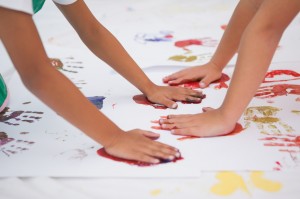Creativity in the Classroom: Bring the Arts Back!

 Most teachers and parents instinctively know that children need various modes of expression to fully develop into thriving, well-rounded adults with good self-esteem and a positive outlook on life. So, why have the arts taken a back burner to reading and math in our schools? Where is the creativity in the classroom?
Most teachers and parents instinctively know that children need various modes of expression to fully develop into thriving, well-rounded adults with good self-esteem and a positive outlook on life. So, why have the arts taken a back burner to reading and math in our schools? Where is the creativity in the classroom?
Off hand, testing pressures from core curriculum standards has wrongfully caused educators to think that the arts will diminish the success of our students. Budgetary constraints have also put many of our art, music, drama and dance programs into the “secondary needs” category or even further down the line.
These decisions are rather ironic. We shouldn’t need to justify our desire to bring back the arts as they afford participants valuable life skills. The fact is that studies consistently show that the arts actually help students to become stronger readers, writers and mathematicians. Not only that, but students who round off their education with the creative arts are also known to be better leaders, have greater confidence and more advanced communication skills. Additionally, people involved in the arts develop greater brain activity as well as the skills of exploration, self-expression, logical thinking, imagination, and creativity.
Here’s a case-in-point: Woodrow Wilson is a pre-kindergarten to eighth grade school located in Union City, New Jersey. Union City has the lowest median family income in New Jersey. 90% of its students are Hispanic. This school has incorporated the Multiple Intelligence Arts Domain (M.I.A.D.) program which allows students to explore the arts and academic areas of their choice through hands-on activities and experiences. Two afternoons a week, students leave their normal classrooms for any of a wide range of creative activities. Should faculty notice a particular area of weakness in a standard lesson, they will try to clarify the problem through the use of the arts.
Additionally, students demonstrate their artistic skills through public demonstrations of their talents which help to develop poise and increase their confidence in front of an audience. Moreover, pupils maintain electronic portfolios of their best work along with written reflections which will help them in their future endeavors.
The school encourages guest artists, actors, musicians, etc. to visit and mentor the students as well as help teachers to introduce creativity in the classroom in order to integrate the arts into the core curriculum. This gives students an extra boost, not only of information but also of hope for their own growing potential.
These programs have had outstanding results. Over 90% of the students have tested well in reading and math proficiency thus proving that the blending of creativity with core curriculum leads not only to success but also can raise people out of poverty.
Although not every school will include M.I.A.D. in their curriculum, there is much that can be done. Firstly, ask your administrators to bring the arts back if they have become obsolete. Secondly, you can introduce creativity in the classroom by integrating various creative learning opportunities into your lesson plans.
- Have students act out historical situations.
- Come up with rhymes or rhythms to remember dates and places.
- Have students take interesting snap shots around their neighborhoods using digital cameras and write captions, advertisements or stories. These pictures can be printed on a standard printer to save money.
- Take advantage of technology. Check Pinterest for great bulletin board ideas and creative projects.
- Have kids sing, put on a show, or practice story telling which can be filmed and placed on YouTube and Snapchat.
- Ask groups of students who play instruments to try to write a musical piece together.
The ideas for creativity in the classroom are endless and the opportunities abound. Hey, ya never know where the next wonder child will sprout from. It may just be from your own classroom.
Does your school or classroom encourage the arts? Let us know.


Leave a Reply